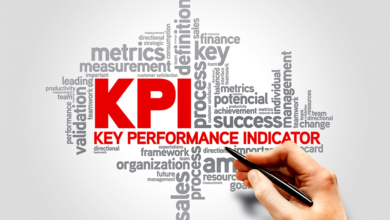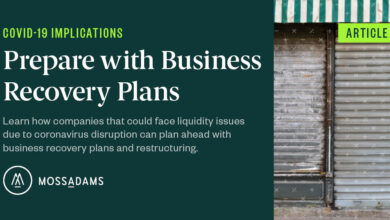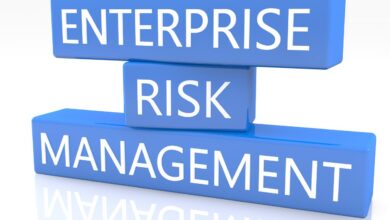
Enterprise Risk Management Success A Comprehensive Guide
Enterprise risk management success isn’t just about avoiding problems; it’s about proactively shaping a resilient future. This guide delves into the intricacies of successful ERM, from defining its core principles to implementing effective strategies and measuring long-term impact. We’ll explore how strong leadership, a proactive risk culture, and advanced technology contribute to a truly successful ERM program. Get ready to unlock the secrets to navigating risks and building a thriving organization.
We’ll cover key performance indicators (KPIs) for measuring success, examining the crucial role of leadership and risk culture. We’ll also dissect various ERM frameworks, comparing and contrasting their approaches. The practical aspects of implementation, including communication, stakeholder engagement, and risk assessments, will be explored. Finally, we’ll analyze case studies of successful and failed implementations, offering invaluable lessons learned.
The future of ERM and emerging trends will also be discussed, providing a forward-looking perspective.
Defining Enterprise Risk Management Success
Enterprise Risk Management (ERM) success isn’t a singular event, but a continuous journey toward a more resilient and adaptable organization. It’s about integrating risk considerations into every aspect of the business, from strategic planning to operational execution. This approach transforms risk from a threat into a catalyst for innovation and growth.A successful ERM program goes beyond simply identifying and mitigating risks.
It’s a holistic process that empowers organizations to proactively anticipate and respond to uncertainties, fostering a culture of vigilance and accountability. It’s not just about avoiding losses; it’s about capitalizing on opportunities presented by risk.
Defining ERM Success
A successful ERM program is characterized by its ability to effectively integrate risk management into the core operations of an organization, enabling proactive identification, assessment, and mitigation of potential threats. This proactive approach, rather than a reactive one, is crucial for maintaining strategic alignment and ensuring long-term value creation. A key aspect of success is demonstrably improved decision-making under uncertainty.
Key Characteristics of a Successful ERM Program
A robust ERM program exhibits several key characteristics. These characteristics are fundamental to its effectiveness and long-term value. A strong risk culture, clearly defined processes, and the utilization of appropriate technology are essential components for success.
- Strategic Alignment: ERM should be deeply integrated into the organization’s strategic planning process. This means that risk considerations are not viewed as an afterthought but as an integral part of defining objectives, setting targets, and developing action plans. Strategic alignment ensures that risk management activities are consistent with the overall strategic direction of the organization.
- Risk Culture: A strong risk culture fosters a proactive and vigilant approach to risk management throughout the organization. This culture encourages open communication, transparency, and a willingness to take calculated risks, while simultaneously emphasizing accountability and responsibility for risk management.
- Processes: Well-defined processes for risk identification, assessment, response planning, and monitoring are critical for consistent application. These processes should be documented, regularly reviewed, and adapted to changing circumstances. A successful ERM program emphasizes the use of a standardized approach to evaluating and managing risk.
- Technology: Effective risk management relies heavily on technology for data collection, analysis, and reporting. Modern tools and systems facilitate the efficient management of risk information, helping organizations gain better visibility and insights into potential threats.
- Reporting & Monitoring: Regular reporting and monitoring are essential for tracking the effectiveness of risk management strategies. Key performance indicators (KPIs) should be established to measure the impact of risk mitigation activities and identify areas for improvement. Consistent monitoring ensures that the ERM program remains aligned with evolving business needs and risks.
Difference Between ERM and Other Risk Management Approaches
Traditional risk management approaches often focus on specific departments or functions, leading to fragmented and inconsistent efforts. ERM, on the other hand, takes a holistic view, integrating risk management into the entire organization. This integrated approach ensures that risks are addressed across all business functions, creating a more cohesive and effective risk management strategy. The integration of risk management into the organization’s decision-making process is a key differentiator from other approaches.
Comparison and Contrast of ERM Frameworks
Various frameworks, such as COSO ERM, ISO 31000, and others, offer valuable guidance for implementing ERM. While they share common principles, they may differ in their specific methodologies and emphasis. A thorough understanding of these differences is essential for selecting the most appropriate framework for a given organization.
Essential Components of a Successful ERM Program
| Component | Description | Metrics | Actions |
|---|---|---|---|
| Strategic Alignment | ERM strategies aligned with business objectives and goals. | Proportion of strategic plans incorporating risk assessments. | Regular review and update of strategic plans with risk considerations. |
| Risk Culture | Open communication, transparency, and accountability regarding risk. | Employee surveys regarding risk awareness and reporting. | Training programs on risk management and ethical considerations. |
| Processes | Well-defined and documented risk management processes. | Timeliness of risk assessments and mitigation actions. | Regular process audits and improvements to optimize efficiency. |
| Technology | Leveraging technology for risk management tools and data analysis. | Data accuracy and accessibility through risk management systems. | Investment in and maintenance of relevant software and hardware. |
| Reporting & Monitoring | Regular reporting and monitoring of risk performance. | Frequency and quality of risk reports. | Establishment of KPIs and regular reviews of ERM effectiveness. |
Identifying Key Performance Indicators (KPIs)
Defining enterprise risk management (ERM) success isn’t just about the absence of crises. It’s about demonstrably achieving better outcomes through proactive risk management. Key Performance Indicators (KPIs) are the metrics that quantify this success, allowing organizations to track progress, identify areas for improvement, and ultimately demonstrate the value of their ERM programs. This section dives into identifying five critical KPIs for measuring ERM success, along with practical measurement methods and real-world examples.
Critical KPIs for ERM Success
Effective ERM programs are characterized by their ability to reduce operational disruptions, minimize financial losses, and enhance organizational resilience. These KPIs provide a clear picture of ERM effectiveness across these crucial aspects.
- Risk Appetite Alignment: This KPI assesses the degree to which risk management strategies effectively reflect the organization’s overall risk appetite. A misalignment indicates that the organization may be exposed to risks that exceed its willingness to accept. Measuring this KPI involves comparing the identified risks to the formally defined risk appetite statements. This comparison should be reviewed periodically and adjusted as needed to ensure alignment.
For instance, a financial institution may have a defined risk appetite for credit losses. Their ERM program would then be measured against the amount of credit losses sustained. If credit losses are consistently exceeding the risk appetite, this KPI indicates a potential issue in the risk management process.
- Risk Event Frequency: This KPI tracks the frequency of risk events that occur within the organization. A decrease in the frequency of these events indicates improved risk mitigation strategies. Measuring this KPI involves tracking incidents, near misses, and other instances of risk events. Examples include the number of security breaches in a technology company or the frequency of supply chain disruptions in a manufacturing company.
Monitoring the frequency of such incidents can be done using incident reporting systems.
- Risk Response Effectiveness: This KPI evaluates the effectiveness of the organization’s risk response strategies. A high score suggests that the organization is effectively mitigating identified risks. This KPI can be measured by analyzing the success rate of implemented risk mitigation strategies. For example, a pharmaceutical company might track the success rate of implementing new safety protocols to reduce manufacturing defects. Another example could be the percentage of successful compliance audits conducted by an organization.
- Compliance Rate: This KPI focuses on the organization’s adherence to internal and external regulations. A high compliance rate signifies a strong risk management system. This is measured by the percentage of regulatory requirements met. This includes tracking regulatory compliance, legal audits, and other relevant compliance procedures. A retailer, for example, would track its compliance with consumer protection laws.
- ERM Program Maturity: This KPI assesses the maturity and sophistication of the organization’s ERM program. A higher maturity score indicates a more robust and effective risk management framework. Measuring this KPI can be accomplished using maturity models. These models often include elements like risk identification, assessment, and response procedures. A company implementing ERM for the first time would score lower on this scale than a company with an established, multi-year ERM program.
KPI Measurement Methods
Accurate measurement of these KPIs is crucial for evaluating ERM effectiveness. A standardized process for tracking and reporting is essential.
Factors Contributing to Success

Enterprise Risk Management (ERM) success isn’t a guaranteed outcome; it’s a carefully cultivated result. Several critical factors influence the effectiveness and longevity of an ERM program. Understanding these factors is crucial for organizations aiming to achieve and maintain a robust risk management framework.A successful ERM program hinges on more than just implementing policies. It necessitates a holistic approach, encompassing leadership commitment, a strong risk culture, technological integration, and practical application within diverse organizational structures.
Each component plays a unique, but interconnected, role in maximizing the value derived from ERM.
Leadership Commitment
Strong leadership commitment is paramount to ERM success. Leaders who champion risk management demonstrate a proactive approach, recognizing risk as an inherent part of the business landscape, not an obstacle to be avoided. This commitment translates into resource allocation, training, and the establishment of clear risk appetite statements. Leaders who actively participate in risk assessments and decision-making processes cultivate a culture of risk awareness throughout the organization.
Risk Culture
A robust risk culture fosters open communication, transparency, and accountability regarding risk. Employees at all levels feel empowered to identify, report, and manage risks, creating a shared responsibility for risk management. This culture emphasizes the importance of ethical conduct, encouraging employees to challenge assumptions and seek alternative solutions.
Technology’s Influence
Technology plays a significant role in modern ERM. Advanced software tools can automate risk assessments, monitor key performance indicators (KPIs), and provide real-time insights into emerging risks. Data analytics capabilities help in identifying patterns and trends, facilitating more informed risk responses. Sophisticated platforms allow for effective collaboration among different departments and stakeholders, ultimately streamlining the entire risk management process.
Examples of Successful ERM Implementation
Numerous organizations have successfully implemented ERM frameworks. For example, companies like Johnson & Johnson have integrated risk management into their core business strategy, leading to a more resilient and adaptable organizational structure. Similarly, financial institutions often employ sophisticated risk models and stress testing methodologies, demonstrating a proactive approach to mitigating potential financial risks. These examples showcase how organizations can leverage ERM to achieve long-term sustainability and profitability.
Factors and their Impact on ERM Success
| Factor | Impact | Example |
|---|---|---|
| Leadership Commitment | Creates a supportive environment for risk management, ensuring resources and commitment from top management. | A CEO actively participating in risk discussions and allocating budget for risk management tools. |
| Strong Risk Culture | Encourages open communication, transparency, and accountability, empowering employees to identify and report risks. | Establishing a dedicated risk reporting channel and rewarding employees for reporting potential issues. |
| Technology Integration | Streamlines risk assessments, monitoring, and reporting, enabling more informed decisions and proactive risk mitigation. | Implementing software that automatically identifies and assesses emerging risks based on historical data and market trends. |
Implementing Effective Strategies

Enterprise Risk Management (ERM) is not a one-time project; it’s a continuous process requiring meticulous implementation. Effective strategies form the bedrock of a successful ERM program, ensuring risks are identified, assessed, and mitigated proactively. This crucial phase demands a structured approach, clear communication, and a commitment from all stakeholders.Establishing a robust ERM program involves a phased approach, starting with a comprehensive risk assessment and culminating in the development of mitigation strategies.
Key elements include clear communication channels, consistent training, and ongoing monitoring to adapt to changing business landscapes. A proactive approach to risk management is essential to maintain a competitive advantage and minimize potential disruptions.
Establishing a Successful ERM Program
A well-structured ERM program begins with a clear understanding of the organization’s objectives and strategic goals. This framework defines the boundaries and scope of the program, ensuring alignment with the overall business strategy. The program should incorporate a robust risk identification process, utilizing diverse sources of information and expert input. Key personnel should be identified and assigned roles, ensuring effective coordination and accountability.
Importance of Communication and Stakeholder Engagement
Effective communication is paramount in an ERM program. Transparent communication fosters buy-in from all stakeholders, including employees, managers, and external partners. Regular updates, clear reporting mechanisms, and accessible information ensure everyone is informed and involved. Open dialogue encourages feedback and participation, allowing for continuous improvement and adaptation to changing circumstances. This fosters a culture of risk awareness and accountability.
Role of Risk Assessments in ERM
Risk assessments are the cornerstone of any effective ERM program. They provide a systematic approach to identifying, analyzing, and evaluating potential risks. Comprehensive risk assessments consider various factors, including likelihood, impact, and potential consequences. These assessments should be regularly reviewed and updated to reflect evolving business conditions and emerging risks. A qualitative or quantitative approach can be applied based on the nature of the risk and the available data.
Methods for Managing Risks Proactively
Proactive risk management involves anticipating potential issues and developing strategies to mitigate their impact. This proactive approach focuses on anticipating potential problems before they materialize. Techniques include scenario planning, stress testing, and developing contingency plans. Regular review and refinement of risk responses are crucial to ensure the program remains relevant and effective.
Best Practices for ERM Implementation
A well-structured ERM program relies on best practices. These best practices are designed to optimize efficiency, effectiveness, and adaptability.
- Establish a dedicated ERM team: This dedicated team ensures consistent oversight and accountability for the ERM program. The team should include individuals with diverse expertise and experience, fostering a comprehensive perspective on risks.
- Develop a robust risk register: A comprehensive risk register catalogs identified risks, their associated likelihood and impact, and mitigation strategies. This central repository provides a clear overview of the organization’s risk profile and facilitates ongoing monitoring and tracking.
- Implement a consistent risk assessment methodology: A standardized approach ensures consistent evaluation of risks across the organization, regardless of department or function. This methodology should be regularly reviewed and refined to maintain relevance and accuracy.
- Establish clear lines of communication and reporting: Clear communication channels and reporting procedures ensure that risk information flows effectively throughout the organization. This ensures timely responses to emerging risks and facilitates effective decision-making.
- Foster a culture of risk awareness: A strong culture of risk awareness emphasizes the importance of risk management across all levels of the organization. This involves training, communication, and leadership commitment to the program.
- Regularly review and update the ERM program: Regular reviews and updates ensure that the ERM program remains aligned with the organization’s strategic objectives and changing business environment. This iterative process allows for flexibility and adaptation.
Measuring and Evaluating ERM Effectiveness
A robust Enterprise Risk Management (ERM) program isn’t just about identifying and assessing risks; it’s about consistently monitoring its effectiveness. Regular evaluation ensures the program remains relevant, adaptable, and capable of mitigating emerging risks. This process provides valuable insights into the program’s strengths and weaknesses, enabling proactive adjustments and ultimately improving organizational resilience.Evaluating ERM effectiveness involves more than just a one-time audit.
It requires a continuous cycle of assessment, analysis, and improvement. By systematically measuring key performance indicators (KPIs), analyzing data, and fostering a culture of continuous improvement, organizations can fine-tune their ERM programs to achieve optimal results.
Methods for Regularly Evaluating the ERM Program
Regular monitoring of the ERM program is crucial for identifying areas requiring attention and adjusting the program accordingly. Various methods can be employed to achieve this, including:
- Key Performance Indicator (KPI) Tracking: Consistent tracking of pre-defined KPIs, such as the number of risks identified, the time taken to respond to risks, or the frequency of risk events, provides a clear picture of the program’s performance over time. This data can be visualized through dashboards and reports for easier interpretation.
- Risk Register Review: Regularly reviewing the risk register allows for the identification of any gaps in risk identification, assessment, or mitigation. It also helps to determine if the current risk profile has changed significantly, which could indicate the need for adjustments to the ERM program.
- Employee Feedback and Surveys: Gathering feedback from employees who interact with the ERM program is vital. This feedback can provide valuable insights into the program’s usability, effectiveness, and potential areas for improvement.
- Benchmarking: Comparing the ERM program’s performance against industry best practices and similar organizations can highlight areas where the program excels and where it needs improvement.
Analyzing ERM Program Data
Analyzing data from the ERM program is not just about collecting numbers; it’s about deriving actionable insights. This involves transforming raw data into meaningful information that guides decision-making. Key aspects of analysis include:
- Trend Analysis: Identifying patterns and trends in risk occurrences, mitigation efforts, and the overall effectiveness of the program. This analysis allows for the prediction of future risks and the proactive development of mitigation strategies.
- Root Cause Analysis: Investigating the underlying causes of risk events to understand the root causes. This step is critical for preventing similar events from occurring in the future and improving the ERM program’s ability to anticipate and respond to potential issues.
- Statistical Modeling: Applying statistical methods to identify correlations and probabilities associated with specific risks, which can inform risk assessment and prioritization.
- Qualitative Data Analysis: Interpreting feedback from employees, stakeholders, and external sources to gain a holistic understanding of the ERM program’s effectiveness and identify potential improvements.
Importance of Continuous Improvement in ERM
The business environment is dynamic, and risks constantly evolve. A static ERM program is doomed to fail. Continuous improvement ensures the program remains relevant and effective. This involves:
- Adapting to Change: Continuously monitoring emerging risks and adjusting the program to address these new threats.
- Leveraging Feedback: Actively seeking feedback from all stakeholders and using this feedback to refine the program’s approach and effectiveness.
- Process Optimization: Improving the efficiency and effectiveness of risk identification, assessment, and mitigation processes.
- Technological Advancement: Integrating new technologies to enhance the program’s capabilities and efficiency.
Examples of ERM Program Evaluations
A company in the financial sector could evaluate the frequency of fraud incidents, comparing them to industry benchmarks and previous years’ data. This data would inform adjustments to fraud prevention protocols. Another example involves a manufacturing company assessing the rate of equipment malfunctions. Analyzing data from maintenance logs, repair records, and production downtime helps identify areas needing investment in preventative maintenance.
Step-by-Step Guide for Conducting an ERM Program Evaluation
- Establish Evaluation Objectives: Clearly define the goals and scope of the evaluation.
- Assemble a Review Team: Gather representatives from various departments to ensure a comprehensive perspective.
- Collect Data: Gather relevant data on KPIs, risk register entries, and stakeholder feedback.
- Analyze Data: Use appropriate methods to analyze collected data, identifying trends and patterns.
- Identify Strengths and Weaknesses: Evaluate the program’s performance, noting its strengths and areas requiring improvement.
- Develop Recommendations: Propose actionable strategies to address weaknesses and reinforce strengths.
- Implement Changes: Implement the recommended improvements and track their impact.
- Monitor and Review: Continuously monitor the effectiveness of implemented changes and make adjustments as needed.
Case Studies and Real-World Examples
Enterprise Risk Management (ERM) isn’t just a theoretical concept; it’s a practical tool for navigating the complexities of the modern business landscape. Successful ERM implementations demonstrate tangible benefits, while failures highlight critical areas for improvement. Examining real-world examples provides valuable insights into how to effectively manage risks and achieve desired outcomes.
A Successful ERM Implementation: XYZ Corporation, Enterprise risk management success
XYZ Corporation, a multinational manufacturing firm, implemented a comprehensive ERM program to address growing operational and financial risks. Initially, XYZ faced challenges with siloed departments, leading to inconsistent risk assessments and mitigation strategies. Their program focused on integrating risk management across all departments, establishing a centralized risk register, and developing a robust communication framework. Key strategies included scenario planning for potential disruptions, such as supply chain issues and regulatory changes, and the implementation of robust contingency plans.
- Improved Decision-Making: ERM empowered managers at all levels to proactively assess and address risks, leading to more informed decisions and improved operational efficiency. The centralized risk register facilitated quick access to relevant information, allowing for faster response times to emerging threats.
- Enhanced Stakeholder Confidence: The transparent risk management processes fostered greater confidence among stakeholders, including investors, customers, and employees. Clear communication channels ensured that risks and mitigation strategies were consistently communicated across the organization.
- Reduced Financial Losses: By proactively identifying and mitigating risks, XYZ Corporation minimized potential financial losses. Early identification of potential supply chain disruptions allowed them to implement alternative sourcing strategies, preventing significant production delays and financial setbacks.
A Failed ERM Implementation: ABC Company
ABC Company, a rapidly expanding technology startup, attempted to implement an ERM program but ultimately failed to achieve its objectives. The primary reason for failure was a lack of executive sponsorship and commitment. The program was perceived as a bureaucratic exercise rather than a strategic initiative, and senior leadership didn’t actively champion its implementation or integration into daily operations.
Furthermore, the program lacked clear ownership and accountability, resulting in inconsistent implementation and a lack of follow-through.
- Lack of Executive Sponsorship: Without the active support of top management, the ERM program lacked the necessary resources, budget, and authority to succeed. This absence of leadership created a sense of detachment and skepticism among employees.
- Inadequate Communication: The lack of clear communication and training hindered the understanding and adoption of ERM principles. Employees were not adequately informed about the program’s objectives, processes, and benefits.
- Failure to Integrate ERM into Core Processes: The ERM program remained a separate entity rather than being embedded into the daily operations of the company. This separation meant that risks were not considered during decision-making processes, leading to ineffective mitigation efforts.
A Detailed Description of a Successful ERM Program
A successful ERM program is characterized by a well-defined scope, comprehensive risk assessment, proactive mitigation strategies, and consistent monitoring and evaluation. It’s not a one-time event but an ongoing process that evolves with the organization’s needs and external environment. The program should be aligned with the company’s strategic objectives and integrated into all decision-making processes.
- Clearly Defined Scope: The program should explicitly identify the types of risks to be addressed and the level of detail required for each risk assessment. This ensures that the program focuses on the most critical risks and avoids unnecessary complexity.
- Robust Risk Assessment Methodology: Using a structured methodology, the program should systematically identify, analyze, and evaluate potential risks. This includes assessing the likelihood and impact of each risk, considering both internal and external factors.
- Effective Mitigation Strategies: Once risks are identified and assessed, appropriate mitigation strategies are developed and implemented. These strategies should be tailored to the specific nature and characteristics of each risk.
The Future of Enterprise Risk Management Success
Enterprise Risk Management (ERM) is no longer a luxury but a necessity in today’s complex and dynamic business environment. Successfully navigating the future demands a proactive and forward-thinking approach to risk identification, assessment, and mitigation. This necessitates a deep understanding of emerging trends, technological advancements, and global influences that will shape the landscape of ERM in the years to come.The future of ERM hinges on organizations’ ability to adapt to unforeseen challenges and capitalize on opportunities presented by the evolving business landscape.
This involves a shift from reactive measures to proactive strategies, requiring a comprehensive understanding of emerging risks and the development of flexible and resilient ERM frameworks.
Emerging Trends in ERM
The risk landscape is constantly shifting. Organizations need to stay abreast of these developments to ensure their ERM strategies remain relevant and effective. Key emerging trends include a greater emphasis on interconnected risks, a focus on resilience and adaptability, and the increasing importance of data-driven decision-making in ERM.
Technology Shaping the Future of ERM
Technology is revolutionizing the way organizations manage risk. Advanced analytics, AI, and machine learning are enabling more sophisticated risk assessments, predictive modeling, and real-time monitoring. This allows for faster identification of potential threats and enables proactive mitigation strategies. For instance, AI-powered systems can analyze vast datasets to identify patterns and anomalies, enabling early detection of emerging risks.
Impact of Globalization on ERM
Globalization introduces a multitude of new risks. Organizations operating in diverse markets face a complex web of regulatory compliance, geopolitical instability, and supply chain disruptions. These factors require a global perspective in ERM, incorporating diverse perspectives and adapting strategies to local market conditions. Consider, for example, the increasing interconnectedness of global supply chains. A disruption in one region can rapidly impact businesses worldwide.
Emerging Risks
The future presents a unique set of challenges. Emerging risks include cyber threats, climate change impacts, and reputational damage. These are not isolated events but rather interconnected threats that demand integrated risk management strategies. For example, a cyberattack can cripple an organization’s operations, while climate change impacts can disrupt supply chains and damage infrastructure.
Preparing for Future Risks
Organizations must proactively anticipate and prepare for emerging risks. This includes developing robust contingency plans, building resilience into operations, and fostering a culture of risk awareness. Investing in diverse talent and developing comprehensive risk response protocols are crucial elements of this preparation.
Future ERM Strategies
Forward-thinking ERM strategies will prioritize agility and adaptability. Organizations need to be prepared to quickly adjust their strategies in response to evolving risks. This necessitates a focus on data-driven decision-making, continuous improvement, and strong communication channels across the organization. For example, organizations can establish cross-functional teams to identify and address emerging risks, promoting collaboration and information sharing.
Last Recap
In conclusion, achieving enterprise risk management success requires a multifaceted approach that encompasses strategic alignment, a robust risk culture, effective processes, and the right technology. The key is understanding and proactively managing risks, not just reacting to them. By implementing the strategies Artikeld in this guide, organizations can build a sustainable foundation for long-term resilience and growth. Continuous evaluation and improvement are essential to maintaining success in the ever-evolving risk landscape.
Question Bank: Enterprise Risk Management Success
What are some common mistakes in implementing ERM?
Lack of executive sponsorship, inadequate risk assessments, neglecting communication and stakeholder engagement, and insufficient monitoring and evaluation are common pitfalls in ERM implementation. These can lead to a program that’s ineffective or doesn’t achieve its intended goals.
How can I ensure my ERM program is aligned with my organization’s strategy?
Regular communication and collaboration between risk management and strategic planning teams is crucial. ERM initiatives should be explicitly tied to strategic objectives, with clear lines of accountability. This alignment ensures that risk management activities directly support the organization’s overall goals.
What are the essential components of a strong risk culture?
A strong risk culture is characterized by open communication, a willingness to report risks, and a commitment to ethical conduct. Leaders must model appropriate behavior and foster an environment where individuals feel comfortable raising concerns and taking ownership of risk mitigation.
How does technology impact enterprise risk management?
Technology plays a critical role in automating risk assessments, providing real-time data analysis, enhancing reporting capabilities, and facilitating communication. This allows for a more efficient and comprehensive risk management process.




